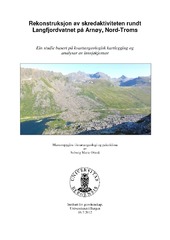| dc.description.abstract | In this study from Lake Langfjordvatnet at Arnøy, northern Troms, a large rock slope failure has been mapped and dated. In addition the Holocene snow avalanche activity has been reconstructed based on layers of avalanche deposits found in two piston cores retrieved at different locations in Lake Langfjordvatnet. An age-depth model for the sediment cores is interpolated based on 9 radiocarbon dates form one core. Physical and chemical sediment properties are analysed in order to separate the continuous organic and minerogenic sedimentation, from the episodic events recorded in the sediment cores. The time series goes back ~16 400 cal. yrs BP, and the deglaciation (16400-15800 cal. yrs BP), a period of cirque glacier activity (15800-11300 cal yrs BP), one rock slope failure, and a Holocene snow avalanche record are identified in the two sediment cores. Previously dated rock slope failures in the fjord areas of Troms are assigned an age of 10500 to 11500 cal. yrs BP. These ages suggest that the triggering mechanisms are related to the deglaciation of the area, causing pressure release, melting of permafrost, earthquakes and crustal movements due to isostatic uplift. The same mechanisms are suggested for the rock slope failure at Arnøy, however, at an earlier stage. At the outermost coast of Nord-Troms the deglaciation started earlier than further inland, and the age of the studied rock slope failure at Arnøy (dated between 13500-14500 cal. yrs BP) therefore is coherent with the observed regional pattern. Paleo records of snow avalanche activity are few, but are an important tool to improve knowledge of the coupling between climate and the frequency of snow avalanches. Results from this study show that the snow avalanche activity was low during the relatively warm early-Holocene, and increased after ~5500 cal. yrs BP. Higher frequency of snow avalanches is recorded in the periods between 2800-2100 and 1600-1150 cal. yrs BP, at the same time as the equilibrium line altitude of two nearby costal glaciers is lowered. This suggests that both the avalanche activity and the glaciers are controlled by the same climatic factors in the late- Holocene. However, no snow avalanches have been recorded during the Little Ice Age when the two glaciers reached their Holocene maximum extent. To isolate potential local influence on the snow avalanche record, more time series from Arctic Norway are needed to improve the knowledge of regional snow avalanche activity. | en_US |
